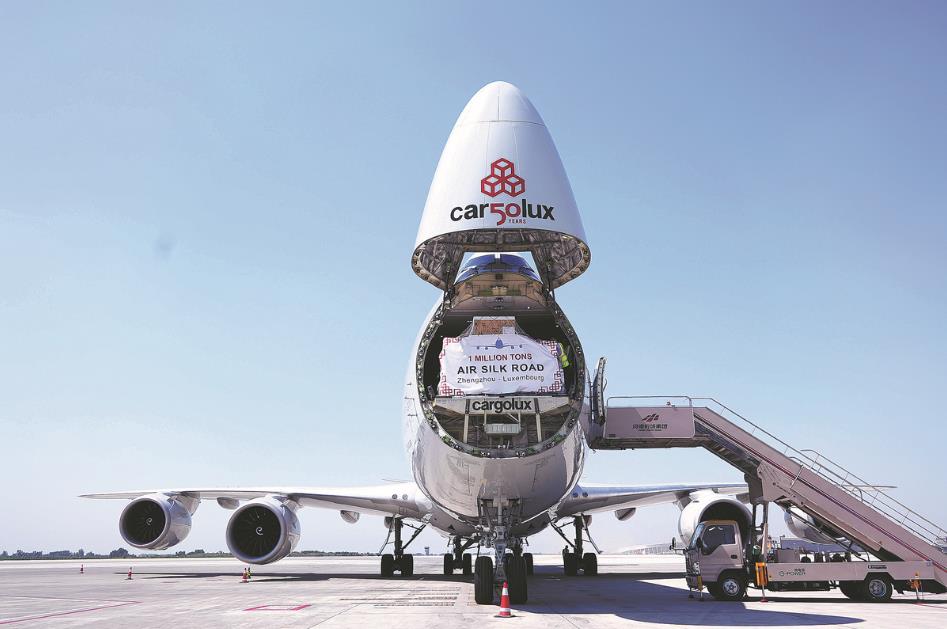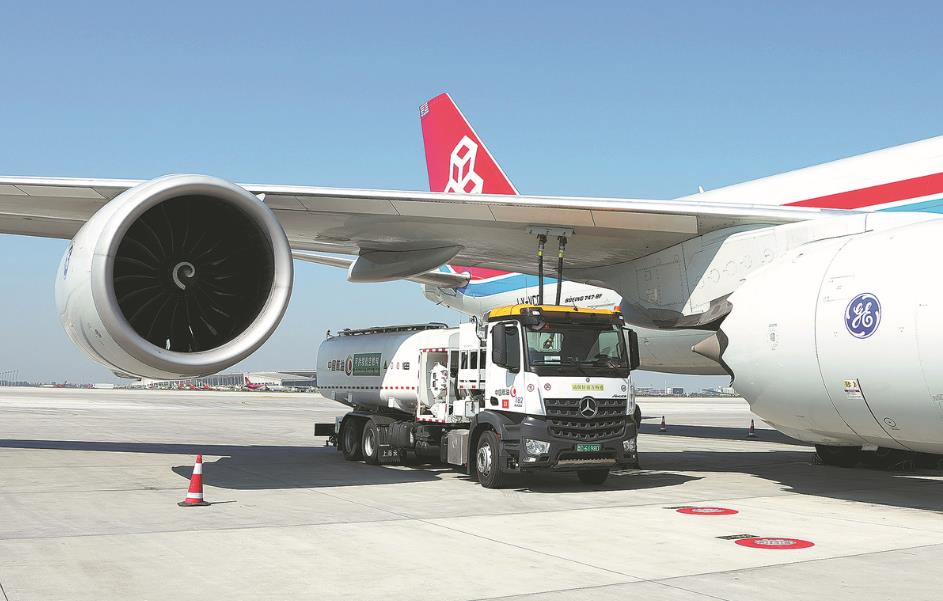源自《China Daily》:https://enapp.chinadaily.com.cn/a/202308/08/AP64d1a269a31003c0fbfbcc61.html

A jetliner of Luxembourg-based Cargolux Airlines International arrives in Zhengzhou, Henan province, in June. [Photo/Xinhua]
Six-year-old cargo transport deal with Henan province also setting green milestones
A decade ago, Central China's Henan province didn't have an established intercontinental freight route network. Now, rapid growth of the Air Silk Road between Zhengzhou, Henan, and Luxembourg, has made it convenient for Henan consumers to get products delivered to their doorsteps from around the world.
China began to support building a bidirectional Air Silk Road between Zhengzhou and Luxembourg in 2017. The service range of the Air Silk Road now covers more than 200 cities in over 20 European countries and some 90 cities across China, said the National Development and Reform Commission.
The route's operators — Henan Civil Aviation Development and Investment Group (HNCA) and Luxembourg-based Cargolux Airlines International — have set up a dual hub strategy to develop a European logistics hub at Luxembourg's airport and a Chinese logistics hub at Zhengzhou Xinzheng International Airport. In 2014, HNCA acquired a 35 percent stake in Cargolux.
Since the building of the Air Silk Road six years ago, Cargolux has achieved new breakthroughs. In 2022, the carrier's net profit reached nearly $1.6 billion, a record high and ranking fifth among all cargo airlines globally.
Now, Cargolux operates more than 50 weekly flights with China, connecting cities such as Zhengzhou, Beijing, Shanghai, Xiamen of Fujian province, and Hong Kong.
"The Air Silk Road has helped strengthen the status of Henan as a transportation hub of inland China. It has made an important contribution to trade growth between China and Europe, and promoted commercial exchanges," said Song Jingwu, vice-president of the China-EU Association.
In June, a group of senior executives at Cargolux and its professional managers in the Asia-Pacific region attended a meeting in Zhengzhou. It was the first meeting the carrier held in the region after the COVID-19 pandemic, showing its confidence in the dual-hub strategy and future business growth potential in China.
Richard Forson, president and CEO of Cargolux, said the carrier usually gathers managers of different regions in Luxemburg for meetings. But Zhengzhou serves as a second home for Cargolux, and the carrier needs to capture and respond to market demand more quickly and become better acquainted with the city.
For Cargolux, the Asian market accounts for one-third of its global business volume and serves as an important growth engine for its business.
Luxembourg's Prime Minister Xavier Bettel said earlier that the Air Silk Road between the two countries is not an empty slogan. Instead, it serves as one of the most visible and tangible pillars of bilateral cooperation.
"We stand ready in the framework of the Air Silk Road to contribute to the development of Chinese trade and services, boosting high-quality growth and innovations," Bettel said via video link.
Meanwhile, the Zhengzhou-Luxembourg Air Silk Road is on a path to greener operations. On June 15, a Boeing B747 freighter operated by Cargolux departed from Zhengzhou to Luxembourg. It was the first cargo flight operating between the two countries that used 10 percent of sustainable aviation fuel.
"We hope Zhengzhou and Luxemburg will strengthen cooperation in the research, development and application of SAF, and make the Air Silk Road greener in the next decade," said Zhai Dongsheng, director of the Belt and Road Initiative Center of the NDRC.
SAF is a liquid fuel used in commercial aviation. Compared with fossil fuels mainly used by carriers, SAF can help reduce carbon dioxide emissions by 80 percent or more. Based on the analysis of the International Air Transport Association, 65 percent of civil aviation carbon emission reductions are expected to be achieved by using SAF by 2050.
"Air transportation is irreplaceable in contributing to domestic and international communications. Carbon emission reductions in the civil aviation sector have been a long process and positive achievements have been gradually emerging," said Yu Zhanfu, a partner of consultancy Roland Berger.
Currently, Cargolux operates intercontinental freight routes connecting Zhengzhou with 15 foreign destinations including Luxembourg, London, Budapest, Milan, Chicago and Atlanta. Those flights include direct flights and flights with stopovers.
At the same time, Henan has continued to develop its aviation manufacturing sector. With an investment of 1 billion yuan ($139 million), the first phase of an aviation industrial park in Zhengzhou can manufacture more than 50 sets of simulators annually. These include cabin simulators, firefighting simulators and cabin service training simulators, said the HNCA.
Next, more aviation simulation equipment manufactured in Henan is expected to be exported, and more foreign pilots and flight assistants will learn related professional skills with the equipment, the company said.

A Cargolux aircraft refuels at Zhengzhou Xinzheng International Airport. [Photo/Xinhua]
For the global air cargo markets, based on data released by the IATA in May, it showed weak market conditions. Global demand, measured in cargo ton-kilometers, fell 5.2 percent compared with May 2022.
Capacity, as measured by available cargo ton-km, rose 14.5 percent compared with May 2022, primarily driven by belly capacity, which increases as demand in the passenger business recovers. Capacity is now 5.9 percent above pre-pandemic levels seen in May 2019.
This year, global cargo volume is expected to reach 57.8 million tons, slipping below the level of 61.5 million tons carried in 2019, with a sharp slowing of international trade volume. Cargo revenue is expected to reach $142.3 billion. While that is down sharply from $210 billion in 2021 and $207 billion in 2022, it is well above the $100 billion earned in 2019, the IATA said.
Asia-Pacific airlines saw their air cargo volumes decline 3.3 percent in May year-on-year. The level dipped 0.3 percent compared with April, mainly due to greater annual contractions in international air cargo demand. Available capacity in the region increased 38.3 percent compared with May 2022, as more belly capacity came online from the passenger side of the business, the IATA said.
"Trading conditions for air cargo continue to be challenging, with several economic indicators pointing toward weakness. The second half of the year, however, should bring some improvements," said Willie Walsh, IATA's director-general.
"Priorities for this year include SAF production incentives to accelerate progress toward net zero carbon emissions, eliminating inefficiencies in air traffic management and applying global standards consistently," said Walsh.








